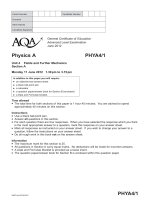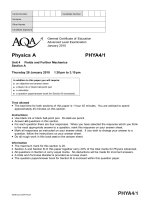AQA PHYA4 2 QP JUN13
Bạn đang xem bản rút gọn của tài liệu. Xem và tải ngay bản đầy đủ của tài liệu tại đây (556.11 KB, 12 trang )
Centre Number
For Examiner’s Use
Candidate Number
Surname
Other Names
Examiner’s Initials
Candidate Signature
Question
General Certificate of Education
Advanced Level Examination
June 2013
Mark
1
2
3
Physics A
PHYA4/2
4
5
Unit 4 Fields and Further Mechanics
Section B
TOTAL
Thursday 13 June 2013 1.30 pm to 3.15 pm
For this paper you must have:
l a calculator
l a ruler
l a Data and Formulae Booklet (enclosed).
Time allowed
l The total time for both sections of this paper is 1 hour 45 minutes.
You are advised to spend approximately one hour on this section.
Instructions
l Use black ink or black ball-point pen.
l Fill in the boxes at the top of this page.
l Answer all questions.
l You must answer the questions in the space provided. Answers written
in margins or on blank pages will not be marked.
l Do all rough work in this book. Cross through any work you do not
want to be marked.
l Show all your working.
Information
l The marks for questions are shown in brackets.
l The maximum mark for this paper is 50.
l You are expected to use a calculator where appropriate.
l A Data and Formulae Booklet is provided as a loose insert.
l You will be marked on your ability to:
– use good English
– organise information clearly
– use specialist vocabulary where appropriate.
(JUN13PHYA4201)
WMP/Jun13/PHYA4/2
PHYA4/2
Do not write
outside the
box
2
Answer all questions in the spaces provided.
You are advised to spend approximately one hour on this section.
1 (a)
A simple pendulum is given a small displacement from its equilibrium position and
performs simple harmonic motion.
State what is meant by simple harmonic motion.
..............................................................................................................................................
..............................................................................................................................................
..............................................................................................................................................
..............................................................................................................................................
(2 marks)
1 (b) (i) Calculate the frequency of the oscillations of a simple pendulum of length 984 mm.
Give your answer to an appropriate number of significant figures.
frequency ....................................... Hz
(3 marks)
1 (b) (ii) Calculate the acceleration of the bob of the simple pendulum when the displacement
from the equilibrium position is 42 mm.
acceleration .................................... m s–2
(2 marks)
(02)
WMP/Jun13/PHYA4/2
Do not write
outside the
box
3
1 (c)
A simple pendulum of time period 1. 90 s is set up alongside another pendulum of time
period 2. 00 s. The pendulums are displaced in the same direction and released at the
same time.
Calculate the time interval until they next move in phase. Explain how you arrive at
your answer.
..............................................................................................................................................
..............................................................................................................................................
..............................................................................................................................................
..............................................................................................................................................
..............................................................................................................................................
time interval .......................................... s
(3 marks)
10
Turn over for the next question
Turn over
(03)
ᮣ
WMP/Jun13/PHYA4/2
Do not write
outside the
box
4
2
Figure 1 shows an arrangement to demonstrate sparks passing across an air gap
between two parallel metal discs. Sparks occur when the electric field in the gap
becomes large enough to equal the breakdown field strength of the air. The discs form a
capacitor, which is charged at a constant rate by an electrostatic generator until the
potential difference (pd) across the discs is large enough for a spark to pass. Sparks are
then produced at regular time intervals whilst the generator is switched on.
Figure 1
electrostatic
generator
metal discs
air gap
12 mm
2 (a)
The electrostatic generator charges the discs at a constant rate of 3. 2 × 10–8 A on a day
when the minimum breakdown field strength of the air is 2. 5 × 106 V m–1. The discs
have a capacitance of 3. 7 × 10–12 F.
2 (a) (i) The air gap is 12 mm wide. Calculate the minimum pd required across the discs for a
spark to occur. Assume that the electric field in the air gap is uniform.
pd ......................................... V
(1 mark)
(04)
WMP/Jun13/PHYA4/2
Do not write
outside the
box
5
2 (a) (ii) Calculate the time taken, from when the electrostatic generator is first switched on, for
the pd across the discs to reach the value calculated in part (a)(i).
time .......................................... s
(2 marks)
2 (b)
The discs are replaced by ones of larger area placed at the same separation, to give a
larger capacitance.
State and explain what effect this increased capacitance will have on:
2 (b) (i) the time between consecutive discharges,
..............................................................................................................................................
..............................................................................................................................................
..............................................................................................................................................
..............................................................................................................................................
..............................................................................................................................................
(2 marks)
2 (b) (ii) the brightness of each spark.
..............................................................................................................................................
..............................................................................................................................................
..............................................................................................................................................
..............................................................................................................................................
..............................................................................................................................................
(2 marks)
Turn over
(05)
ᮣ
WMP/Jun13/PHYA4/2
7
Do not write
outside the
box
6
3 (a) (i) State two situations in which a charged particle will experience no magnetic force when
placed in a magnetic field.
first situation ........................................................................................................................
..............................................................................................................................................
..............................................................................................................................................
second situation ...................................................................................................................
..............................................................................................................................................
..............................................................................................................................................
(2 marks)
3 (a) (ii) A charged particle moves in a circular path when travelling perpendicular to a uniform
magnetic field. By considering the force acting on the charged particle, show that the
radius of the path is proportional to the momentum of the particle.
(2 marks)
3 (b)
In a cyclotron designed to produce high energy protons, the protons pass repeatedly
between two hollow D-shaped containers called ‘dees’. The protons are acted on by a
uniform magnetic field over the whole area of the dees. Each proton therefore moves in
a semi-circular path at constant speed when inside a dee. Every time a proton crosses
the gap between the dees it is accelerated by an alternating electric field applied
between the dees. Figure 2 shows a plan view of this arrangement.
Figure 2
path of proton
with higher energy
gap
dees
path of
proton
(06)
WMP/Jun13/PHYA4/2
Do not write
outside the
box
7
3 (b) (i) State the direction in which the magnetic field should be applied in order for the protons
to travel along the semicircular paths inside each of the dees as shown in Figure 2.
..............................................................................................................................................
(1 mark)
3 (b) (ii) In a particular cyclotron the flux density of the uniform magnetic field is 0.48 T.
Calculate the speed of a proton when the radius of its path inside the dee is 190 mm.
speed .................................... m s–1
(2 marks)
3 (b) (iii) Calculate the time taken for this proton to travel at constant speed in a semicircular path
of radius 190 mm inside the dee.
time .......................................... s
(2 marks)
3 (b) (iv) As the protons gain energy, the radius of the path they follow increases steadily, as
shown in Figure 2. Show that your answer to part (b)(iii) does not depend on the radius
of the proton’s path.
..............................................................................................................................................
..............................................................................................................................................
..............................................................................................................................................
..............................................................................................................................................
..............................................................................................................................................
..............................................................................................................................................
(2 marks)
Turn over
(07)
ᮣ
WMP/Jun13/PHYA4/2
Do not write
outside the
box
8
3 (c)
The protons leave the cyclotron when the radius of their path is equal to the outer radius
of the dees. Calculate the maximum kinetic energy, in MeV, of the protons accelerated
by the cyclotron if the outer radius of the dees is 470 mm.
maximum kinetic energy .................................... MeV
(3 marks)
14
4
Gravitational fields and electric fields have many features in common but also have
several differences. For both radial and uniform gravitational and electric fields,
compare and contrast their common features and their differences.
In your answer you should consider:
l the force acting between particles or charges
l gravitational field strength and electric field strength
l gravitational potential and electric potential.
The quality of your written communication will be assessed in your answer.
..............................................................................................................................................
..............................................................................................................................................
..............................................................................................................................................
..............................................................................................................................................
..............................................................................................................................................
..............................................................................................................................................
(08)
WMP/Jun13/PHYA4/2
Do not write
outside the
box
9
..............................................................................................................................................
..............................................................................................................................................
..............................................................................................................................................
..............................................................................................................................................
..............................................................................................................................................
..............................................................................................................................................
..............................................................................................................................................
..............................................................................................................................................
..............................................................................................................................................
..............................................................................................................................................
..............................................................................................................................................
..............................................................................................................................................
..............................................................................................................................................
..............................................................................................................................................
..............................................................................................................................................
..............................................................................................................................................
..............................................................................................................................................
..............................................................................................................................................
..............................................................................................................................................
..............................................................................................................................................
..............................................................................................................................................
(6 marks)
6
Turn over
(09)
ᮣ
WMP/Jun13/PHYA4/2
Do not write
outside the
box
10
5
A rectangular coil is rotating anticlockwise at constant angular speed with its axle at
right angles to a uniform magnetic field. Figure 3 shows an end-on view of the coil at
a particular instant.
Figure 3
rotation
30°
axle
uniform
magnetic
field
coil
5 (a)
At the instant shown in Figure 3, the angle between the normal to the plane of the coil
and the direction of the magnetic field is 30º.
5 (a) (i) State the minimum angle, in degrees, through which the coil must rotate from its
position in Figure 3 for the emf to reach its maximum value.
angle ................................. degrees
(1 mark)
5 (a) (ii) Calculate the minimum angle, in radians, through which the coil must rotate from its
position in Figure 3 for the flux linkage to reach its maximum value.
angle ................................. radians
(2 marks)
5 (b)
Figure 4 shows how, starting in a different position, the flux linkage through the coil
varies with time.
5 (b) (i) What physical quantity is represented by the gradient of the graph shown in Figure 4?
..............................................................................................................................................
(1 mark)
5 (b) (ii) Calculate the number of revolutions per minute made by the coil.
revolutions per minute ..............................................
(2 marks)
(10)
WMP/Jun13/PHYA4/2
Do not write
outside the
box
11
Figure 4
flux
linkage /
Wb turns
0. 5
0
20
40
60
80
time / ms
60
80
time / ms
– 0. 5
Figure 5
induced
emf / V
0
20
40
5 (b) (iii) Calculate the peak value of the emf generated.
peak emf ......................................... V
(3 marks)
5 (c)
Sketch a graph on the axes shown in Figure 5 above to show how the induced emf
varies with time over the time interval shown in Figure 4.
(2 marks)
Turn over
(11)
ᮣ
WMP/Jun13/PHYA4/2
Do not write
outside the
box
12
5 (d)
The coil has 550 turns and a cross-sectional area of 4. 0 × 10–3 m2.
Calculate the flux density of the uniform magnetic field.
flux density .......................................... T
(2 marks)
13
END OF QUESTIONS
Copyright © 2013 AQA and its licensors. All rights reserved.
(12)
WMP/Jun13/PHYA4/2









